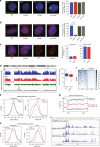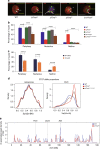Trans- and cis-acting effects of Firre on epigenetic features of the inactive X chromosome
- PMID: 33247132
- PMCID: PMC7695720
- DOI: 10.1038/s41467-020-19879-3
Trans- and cis-acting effects of Firre on epigenetic features of the inactive X chromosome
Abstract
Firre encodes a lncRNA involved in nuclear organization. Here, we show that Firre RNA expressed from the active X chromosome maintains histone H3K27me3 enrichment on the inactive X chromosome (Xi) in somatic cells. This trans-acting effect involves SUZ12, reflecting interactions between Firre RNA and components of the Polycomb repressive complexes. Without Firre RNA, H3K27me3 decreases on the Xi and the Xi-perinucleolar location is disrupted, possibly due to decreased CTCF binding on the Xi. We also observe widespread gene dysregulation, but not on the Xi. These effects are measurably rescued by ectopic expression of mouse or human Firre/FIRRE transgenes, supporting conserved trans-acting roles. We also find that the compact 3D structure of the Xi partly depends on the Firre locus and its RNA. In common lymphoid progenitors and T-cells Firre exerts a cis-acting effect on maintenance of H3K27me3 in a 26 Mb region around the locus, demonstrating cell type-specific trans- and cis-acting roles of this lncRNA.
Conflict of interest statement
The authors declare no competing interests.
Figures








Similar articles
-
The lncRNA Firre anchors the inactive X chromosome to the nucleolus by binding CTCF and maintains H3K27me3 methylation.Genome Biol. 2015 Mar 12;16(1):52. doi: 10.1186/s13059-015-0618-0. Genome Biol. 2015. PMID: 25887447 Free PMC article.
-
X-linked deletion of Crossfirre, Firre, and Dxz4 in vivo uncovers diverse phenotypes and combinatorial effects on autosomes.Nat Commun. 2024 Dec 5;15(1):10631. doi: 10.1038/s41467-024-54673-5. Nat Commun. 2024. PMID: 39638999 Free PMC article.
-
High-resolution analysis of epigenetic changes associated with X inactivation.Genome Res. 2009 Aug;19(8):1361-73. doi: 10.1101/gr.092643.109. Epub 2009 Jul 6. Genome Res. 2009. PMID: 19581487 Free PMC article.
-
A lifelong duty: how Xist maintains the inactive X chromosome.Curr Opin Genet Dev. 2022 Aug;75:101927. doi: 10.1016/j.gde.2022.101927. Epub 2022 Jun 16. Curr Opin Genet Dev. 2022. PMID: 35717799 Free PMC article. Review.
-
Gene regulation by non-coding RNAs in the 3D genome architecture.Curr Opin Genet Dev. 2020 Apr;61:69-74. doi: 10.1016/j.gde.2020.03.002. Epub 2020 May 5. Curr Opin Genet Dev. 2020. PMID: 32387763 Review.
Cited by
-
Aging differentially alters the transcriptome and landscape of chromatin accessibility in the male and female mouse hippocampus.Front Mol Neurosci. 2024 Jan 22;17:1334862. doi: 10.3389/fnmol.2024.1334862. eCollection 2024. Front Mol Neurosci. 2024. PMID: 38318533 Free PMC article.
-
LNCing RNA to immunity.Trends Immunol. 2022 Jun;43(6):478-495. doi: 10.1016/j.it.2022.04.002. Epub 2022 Apr 29. Trends Immunol. 2022. PMID: 35501219 Free PMC article. Review.
-
Single-cell landscape of nuclear configuration and gene expression during stem cell differentiation and X inactivation.Genome Biol. 2021 Sep 27;22(1):279. doi: 10.1186/s13059-021-02432-w. Genome Biol. 2021. PMID: 34579774 Free PMC article.
-
Cis- and trans-action of the cold-induced lncRNAs, SVALKA and SVALNA, regulate CBF1 and CBF3 in Arabidopsis.EMBO Rep. 2025 Sep 1. doi: 10.1038/s44319-025-00568-5. Online ahead of print. EMBO Rep. 2025. PMID: 40890401
-
Identification and Characterization of a Novel Long Noncoding RNA that Regulates Osteogenesis in Diet-Induced Obesity Mice.Front Cell Dev Biol. 2022 Apr 21;10:832460. doi: 10.3389/fcell.2022.832460. eCollection 2022. Front Cell Dev Biol. 2022. PMID: 35531098 Free PMC article.
References
Publication types
MeSH terms
Substances
Grants and funding
LinkOut - more resources
Full Text Sources
Molecular Biology Databases
Research Materials
Miscellaneous

